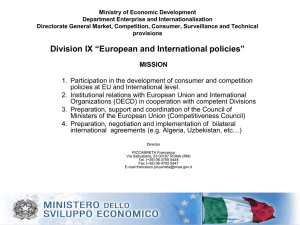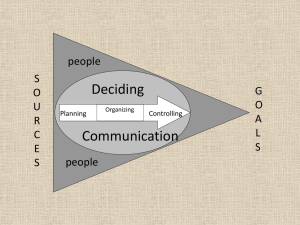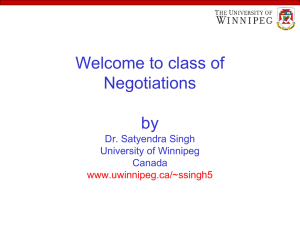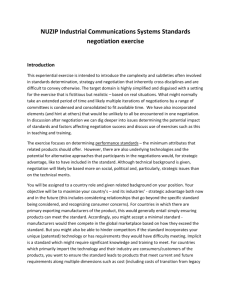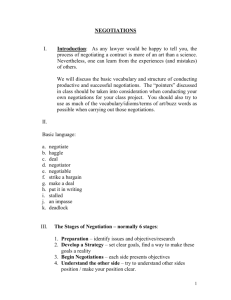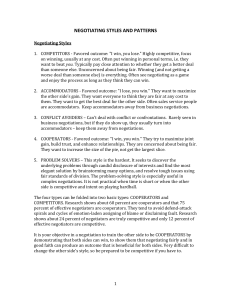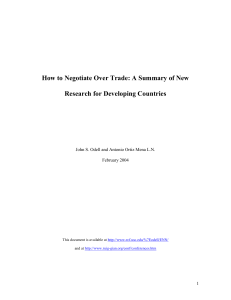Stephen W
advertisement
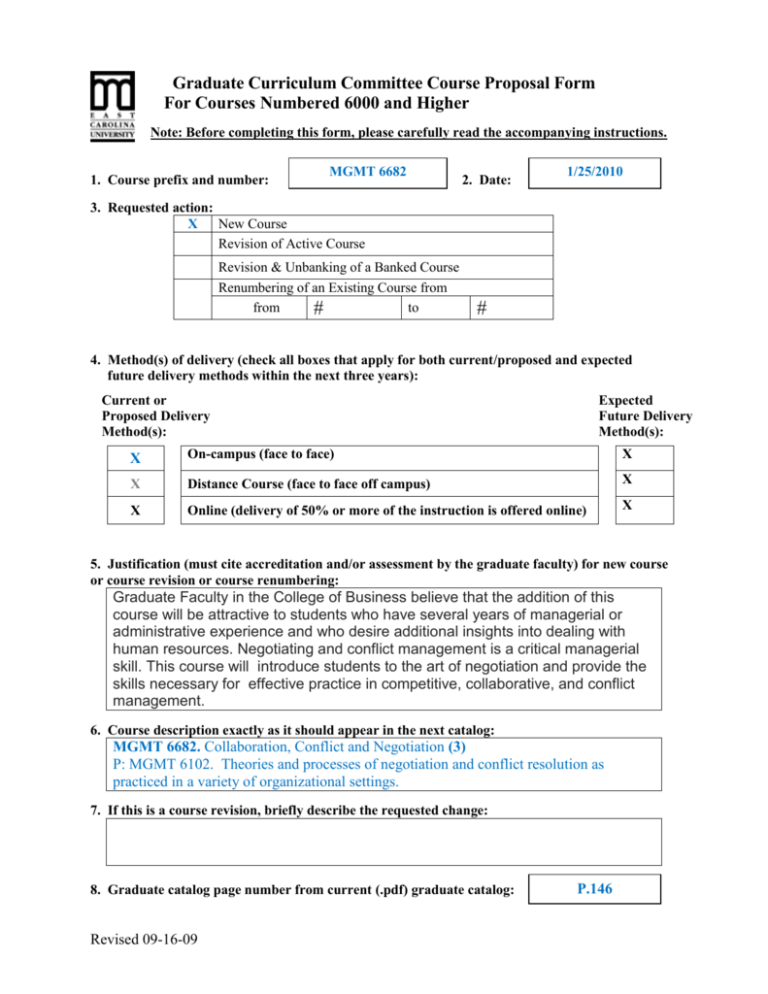
Graduate Curriculum Committee Course Proposal Form For Courses Numbered 6000 and Higher Note: Before completing this form, please carefully read the accompanying instructions. 1. Course prefix and number: MGMT 6682 2. Date: 1/25/2010 3. Requested action: X New Course Revision of Active Course Revision & Unbanking of a Banked Course Renumbering of an Existing Course from from to # # 4. Method(s) of delivery (check all boxes that apply for both current/proposed and expected future delivery methods within the next three years): Current or Proposed Delivery Method(s): Expected Future Delivery Method(s): X On-campus (face to face) X X Distance Course (face to face off campus) X X Online (delivery of 50% or more of the instruction is offered online) X 5. Justification (must cite accreditation and/or assessment by the graduate faculty) for new course or course revision or course renumbering: Graduate Faculty in the College of Business believe that the addition of this course will be attractive to students who have several years of managerial or administrative experience and who desire additional insights into dealing with human resources. Negotiating and conflict management is a critical managerial skill. This course will introduce students to the art of negotiation and provide the skills necessary for effective practice in competitive, collaborative, and conflict management. 6. Course description exactly as it should appear in the next catalog: MGMT 6682. Collaboration, Conflict and Negotiation (3) P: MGMT 6102. Theories and processes of negotiation and conflict resolution as practiced in a variety of organizational settings. 7. If this is a course revision, briefly describe the requested change: 8. Graduate catalog page number from current (.pdf) graduate catalog: Revised 09-16-09 P.146 9. Course credit: Lecture Hours Weekly OR Per Term Credit Hours Lab Weekly OR Per Term Credit Hours s.h. Studio Weekly OR Per Term Credit Hours s.h. Practicum Weekly OR Per Term Credit Hours s.h. Internship Weekly OR Per Term Credit Hours s.h. 3 Other (e.g., independent study) Please explain. Total Credit Hours 10. Anticipated annual student enrollment: 3 s.h. s.h. 25 11. Affected degrees or academic programs: Degree(s)/Program(s) Current Catalog Page Master of Business Adm. 3 p.146 Changes in Degree Hours n/a 12. Overlapping or duplication with affected units or programs: Not applicable X Notification & response from affected units is attached 13. Council for Teacher Education (CTE) approval (for courses affecting teacher education): Not applicable X Applicable and CTE has given their approval. 14. Service-Learning Advisory Committee (SLAC) approval Not applicable X Applicable and SLAC has given their approval. 15. Statements of support: a. Staff X Current staff is adequate Additional staff is needed (describe needs in the box below): b. Facilities X Current facilities are adequate Additional facilities are needed (describe needs in the box below): c. Library X Initial library resources are adequate Initial resources are needed (in the box below, give a brief explanation and an estimate for the cost of acquisition of required initial resources): d. Unit computer resources X Unit computer resources are adequate Revised 09-16-09 Additional unit computer resources are needed (in the box below, give a brief explanation and an estimate for the cost of acquisition): e. ITCS resources X ITCS resources are not needed The following ITCS resources are needed (put a check beside each need): Mainframe computer system Statistical services Network connections Computer lab for students Software Approval from the Director of ITCS attached 16. Course information (see: Graduate Curriculum and Program Development Manual for instructions): a. Textbook(s) and/or readings: author(s), name, publication date, publisher, and city/state/country Fisher, R. and Ury, W. (1991). Getting to Yes. Negotiating Agreement Without Giving In. Penguin Books. New York, New York. USA. Thompson, L.L. (2009). The Mind and Heart of the Negotiator. 4th Edition. Prentice Hall. Upper Saddle River, New Jersey. USA. Additional readings accessible via the current holdings of the ECU library. Cases and bargaining simulations, as assigned. b. Course objectives for the course (student – centered, behavioral focus) At the conclusion of this course, students will be able to: 1. Explain the strategic aspects of negotiations such as interests, goals, alternatives (BATNA [best alternative to a negotiated agreement]), positions, rights, and power. 2. Employ alternative sources of leverage in negotiations. 3. Describe the importance and process of preparation for negotiations. 4. Enhance awareness that the negotiation process is an effective means for resolving conflict in organizations. 5. Evaluate the costs and benefits of alternative actions. 6. Implement the analytical skills necessary to diagnose the behavior of individuals, groups, and organizations in competitive situations c. Course topic outline 1) 2) 3) 4) 5) 6) Introduction and overview of negotiation analysis Foundations of cooperative agreements Planning process and documentation Effective strategies for creating and claiming value in complex negotiations Conflict resolution Negotiating in teams/Multiparty negotiations Revised 09-16-09 7) In-class and group negotiation simulations: a) New Recruit b) Texoil c) Viking Investments d) Harborco e) Adam Baxter/Local 190, 1978 and 1983 rounds (Team negotiation) d. List of course assignment, weighting of each assignment, and grading/evaluation system for determining a grade Class participation (20%) Attendance Feedback Debriefing sessions Planning Documents (20%) The nature and extent of student preparation will be judged from planning documents prepared in advance of each negotiation (New Car, Texoil, Viking, and Harborco exercises). Group project: Multi-round group negotiation (30%) Students will be assigned to groups of three and participate in multi-round negotiation. Groups will be assigned the role either of union representatives or company representatives, and will be paired with another group for three rounds of negotiations. The groups will work together to develop negotiating strategies and complete the negotiations. Following the final round, groups will write and submit a case analysis. Group presentation: Real world case analysis (30%) A separate group of two or three people (not the same group as the assigned group negotiation team) will present in class an analysis of a negotiation in the real world. The topic of the real world negotiation may be any situation that meets the definition of a negotiation: a conflict over resources in which the parties are interdependent and can communicate. Students will be expected to use the planning document framework to analyze each party's interests, alternatives, likely BATNA and reservation point, and target for the negotiation. Students will make a presentation on their analysis; submit PowerPoint slides; and a detailed planning document to support their analysis. The final letter grade will be determined by the following formula: A: 90% – 100% B: 80% – 89% C: 70% – 79% F: below 70% Revised 09-16-09






